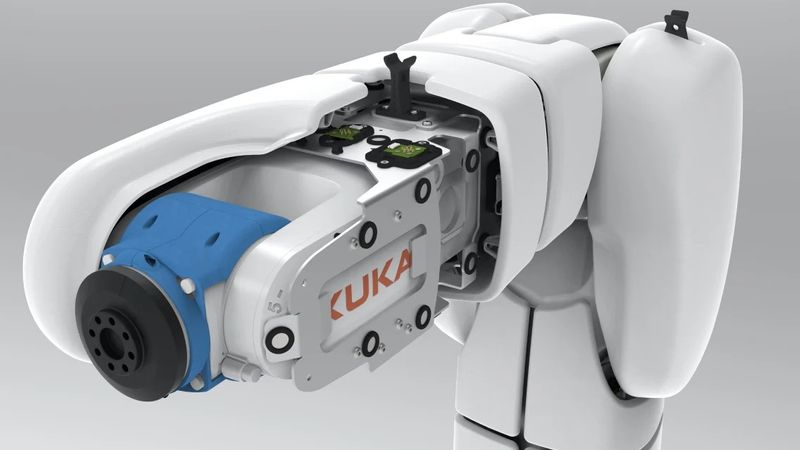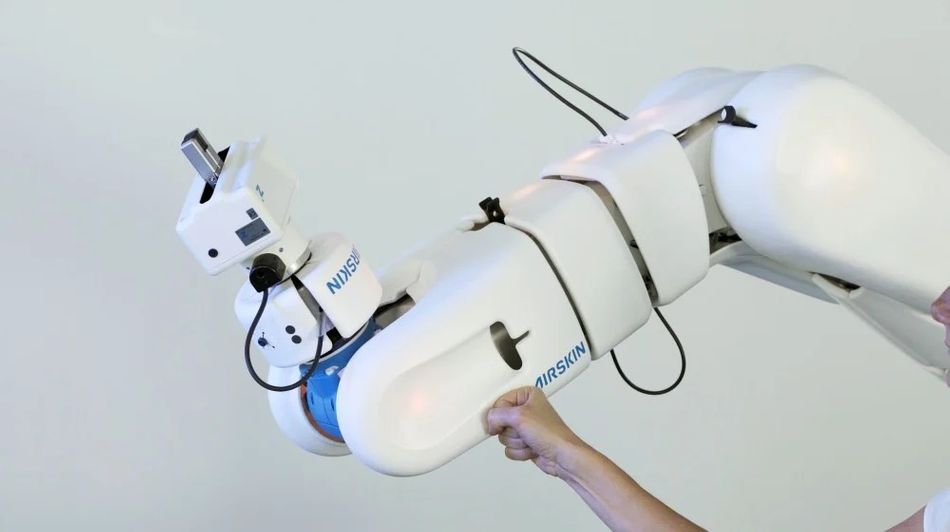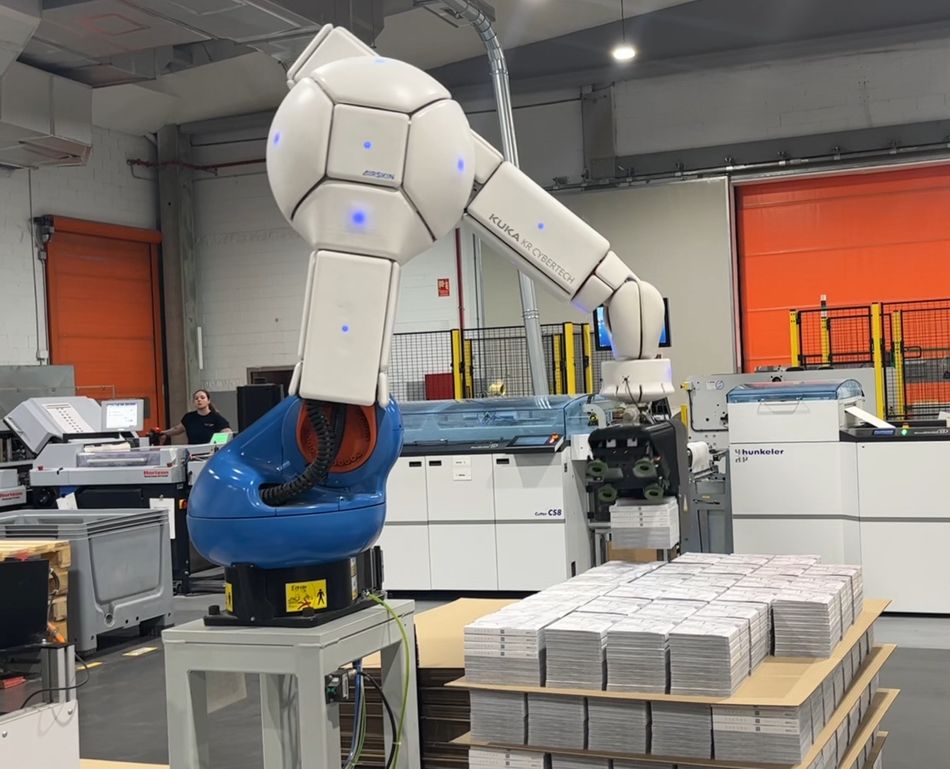Bringing Freedom into Factories: How Air-Powered Tech Paves the Way for Human-Robot Harmony
AIRSKIN® revolutionizes industrial automation by adding air-powered tactile skin for to robots to create safe, collaborative environments, ensuring maximum safety with PLe / Cat. 3 certification.
The integration of robotics into manufacturing has radically boosted efficiency and quality and lowered costs. However, large industrial robots also pose a threat to human safety due to their size, weight, and ‘on/off’ programming. In an effort to solve this problem, collaborative robots, or cobots, have been introduced to manufacturing facilities. These lightweight robots are designed to work alongside human workers. However, cobots cannot do the same grunt work as their more industrial cousins, leaving a gap between the small save robots and the caged larger machines.
Blue Danube Robotics, the company behind AIRSKIN®, aims to solve this industrial automation problem. Their innovative product, AIRSKIN®, is a breakthrough technology designed as a soft, tactile skin for industrial robots, enabling them to work alongside humans safely. This patented solution allows robots to perform a broader range of tasks in close proximity to human workers, revolutionizing how robotic automation integrates into human-centric work environments.
AIRSKIN® enables an open workplace with robots
The integration of robots into the industrial workforce presents a unique set of safety challenges. The limitations of traditional safety measures and even the most advanced cobots have made it clear that a new approach is needed to harmonize human-robot collaboration. This is where AIRSKIN® enters the scene, offering a solution that addresses these challenges.
AIRSKIN® seamlessly integrates with industrial robots and transforms traditional manufacturing setups into collaborative environments. This reduces hazardous collision areas and ensures maximum safety with PLe / Cat. 3 certification.
Upgrade to Collaborative Robots
AIRSKIN® transforms standard industrial robots into fenceless, collaborative robots. This transformation allows robots to operate in close proximity to humans and other machinery, enhancing productivity and efficiency while maintaining a safe working environment. By eliminating the need for physical barriers, AIRSKIN® enables seamless collaboration between humans and robots, optimizing workflow and reducing downtime. AIRSKIN® works with all robots, already off-the-shelves products exist for KUKA (Agilus 2, Cybertech 2, Iontec, Quantec 2), Stäubli (TX2touch) and Epson (Scaraflex).
Innovative Design and Functionality
AIRSKIN® comprises soft and robust air-filled pads mounted on the robot, with embedded safety electronics that monitor internal air pressure and instantly react to contact anywhere on the robot. Dual-channel pressure sensors detect pressure changes, ensuring precise and rapid response to potential collisions in a maximum of 8ms.
Equipped with intelligent sensors and real-time monitoring capabilities, AIRSKIN® detects and responds to potential hazards with precision and speed, mitigating the risk of accidents and injuries. Certified according to ISO 13849 with the highest safety performance level PLe / Cat.3, AIRSKIN® meets all industrial requirements, including high durability and IP54 rating.
AIRSKIN® offers adaptability to various industrial environments and applications, seamlessly integrating into existing workflows. Its space-saving design eliminates the need for physical barriers, optimizing floor space by up to 90% compared to traditional fencing systems, thereby unlocking new possibilities for layout optimization and production line flexibility.
How AIRSKIN® is used
AIRSKIN® can be added to industrial robot applications to enable them to have ‘collaborative’ status by effectively covering all hazardous collision areas. The maximum speed for the robot is based on a risk assessment and can reach up to 2m/s in collaborative mode.
AIRSKIN® can help large payload robots achieve movement speed of beyond 1 m/s, while still maintaining operator safety. The AIRSKIN® Modules help absorb energy and distribute the contact forces associated, helping them avoid serious injury.
Clamping/shearing collisions
For clamping/shearing collisions the robot’s stopping distance must be shorter than the thickness of the soft AIRSKIN®. In order to accommodate these stringent application areas, a risk assessment needs to be done to determine the permissible speed. It must be obtained by measuring contact forces occurring in the collision using an ISO/TS 15066 compliant measurement device.
Advancing Industry 4.0
Robotics is a pivotal component of Industry 4.0. AIRSKIN® enables companies to convert existing robotic setups to collaborative, human-safe zones. This can radically increase efficiency by reducing downtime usually created by safety cage protocols. It also enables more agile and customized workflows, which are integral to meeting industry 4.0 goals.
Industry 4.0 benefits With AIRSKIN®
Speed: Up to 6 times faster than applications with cobots, achieving speeds of up to 2 m/s for collaboration.
Flexibility: Safety system mounted on the robot offers flexibility in location and task execution.
Space Optimization: Optimizing installation footprint by up to 90%, maximizing operational efficiency.
Payload & Reach: Supporting a wide range of payloads and reaches for various robotic applications. – like AIRSKIN for KUKA Quantec – up to 300 kg payload
Precision: Offering highest accuracy, repeatability, and path consistency for precise operations.
Risk Assessment: Prepared safety concept simplifies application assessments, ensuring compliance with safety standards.
AIRSKIN Safetyflange: Advancing Safety and Efficiency
AIRSKIN Safetyflange, a compliant robotic collision sensor, extends the safety benefits of AIRSKIN® technology to protect tools, workpieces, and individuals from potential hazards. Designed for easy mounting with any robot and end-of-arm tool, AIRSKIN Safetyflange ensures compliance with safety standards while maximizing workplace safety without compromising productivity.
Key Features:
Finger-Safe Applications: Eliminates crushing and clamping risks, ensuring compliance with safety standards.
Adjustable Break-Away Forces: Absorbs energy and reduces pressure and force during collisions in collaborative applications.
Compliance in All Directions: Adjustable compliance minimizes contact forces, maximizing workplace safety.
Easy Mounting Compatibility: Simplifies integration with any robot and tool using exchangeable ISO 9409-1 adapters.
Safety Certification: Complies with the PLe / Cat. 3 ISO 13849 safety certification, setting a new standard for safe and efficient operations.
Versatile Applications
AIRSKIN Safetyflange is suitable for a wide range of applications, including palletizing, machine tending, visual inspection, gluing, and more, making it a versatile solution for enhancing safety and efficiency in industrial environments.
AIRSKIN® marks a pivotal advancement in the sphere of industrial automation, fundamentally transforming how safety and efficiency are perceived and implemented in collaborative workspaces. By integrating AIRSKIN® into your operations, your business can set new benchmarks for what is possible to achieve with human-robot collaboration. There is immense potential for AIRSKIN®-equipped robots to redefine and enrich collaborative workspaces, allowing a future where robots and humans can work side by side with unprecedented efficiency and safety.
As we move further into the Industry 4.0 era, the impact of AIRSKIN® represents the endless possibilities at the intersection of innovation, safety, and collaboration. It fosters a new period of industrial productivity and human-centric automation.



